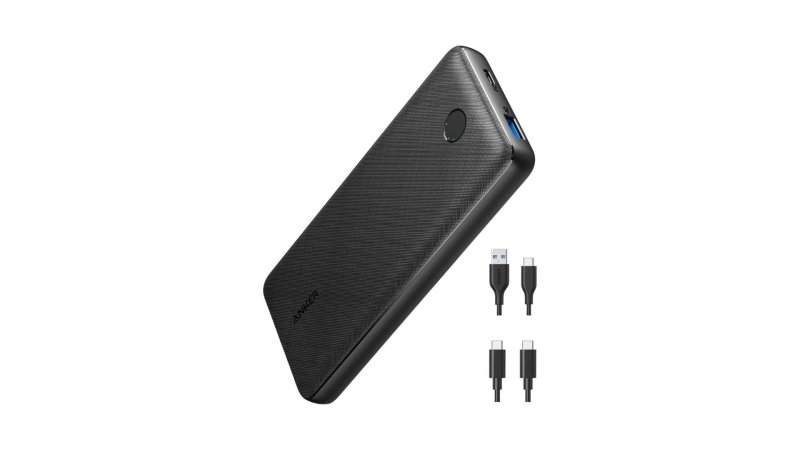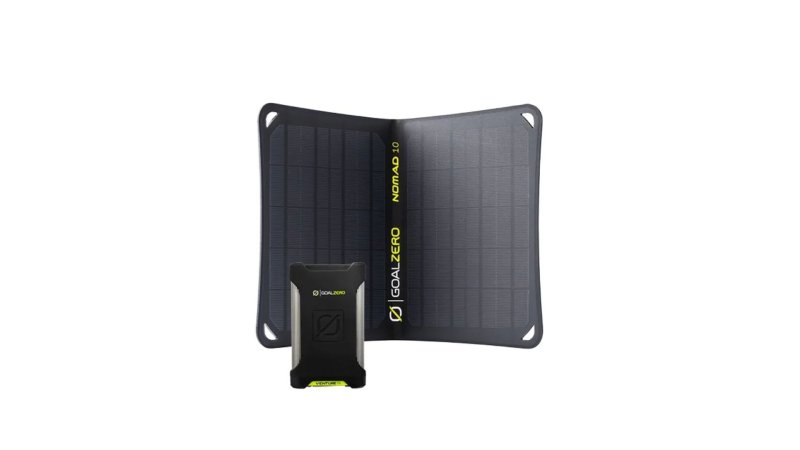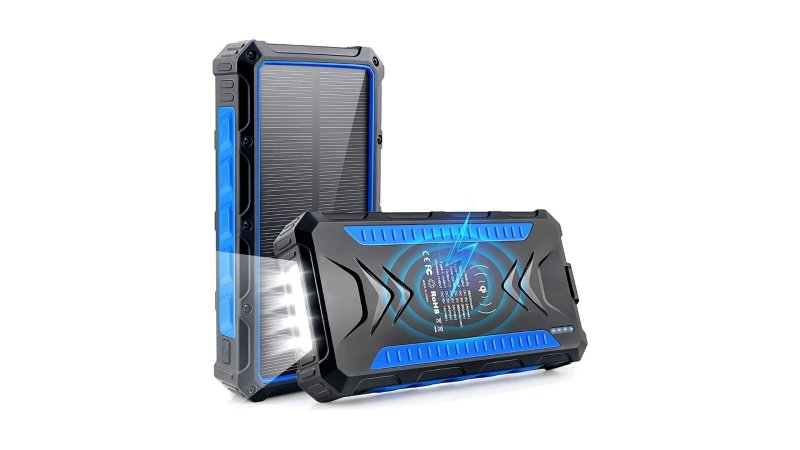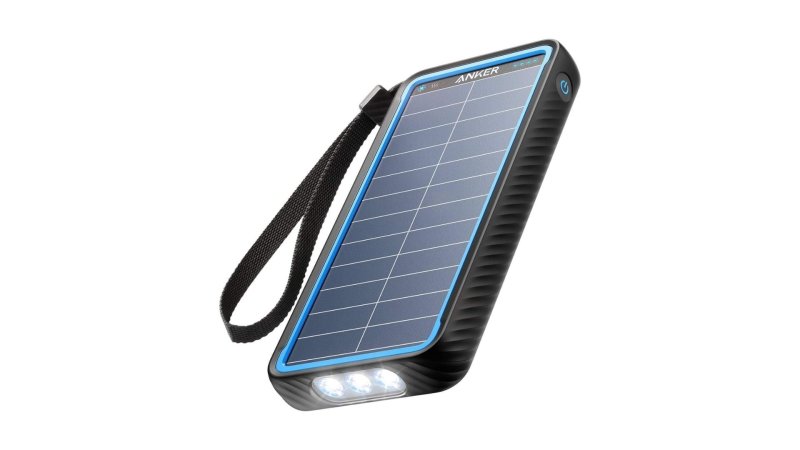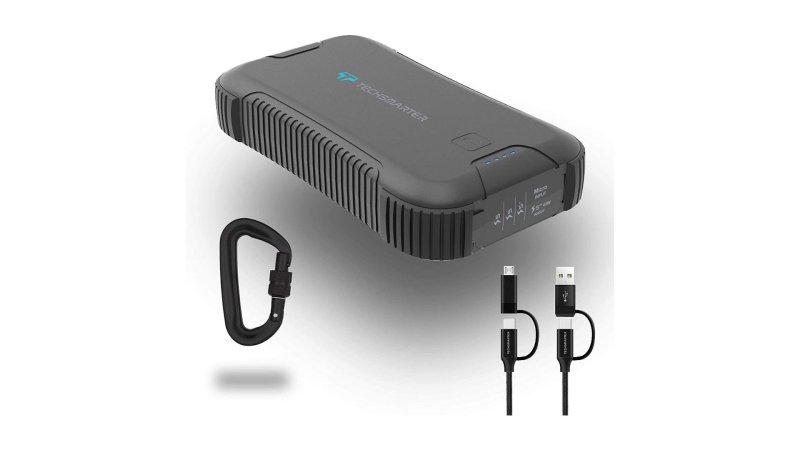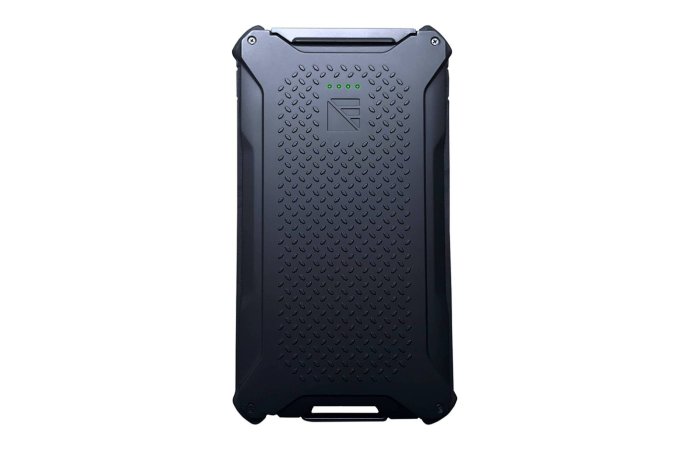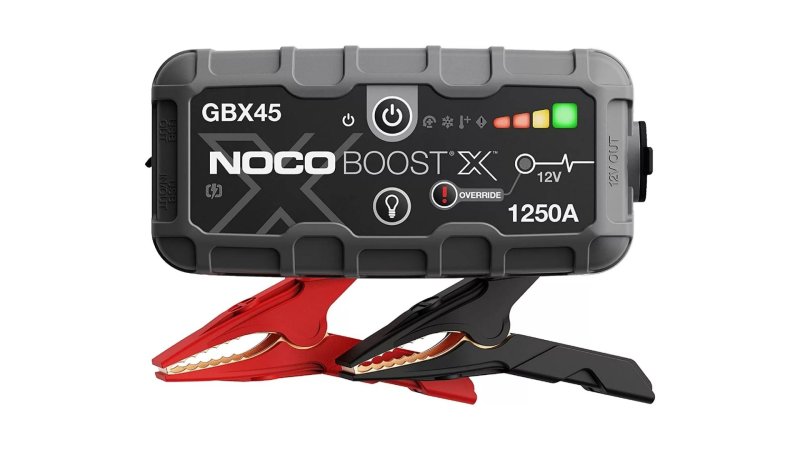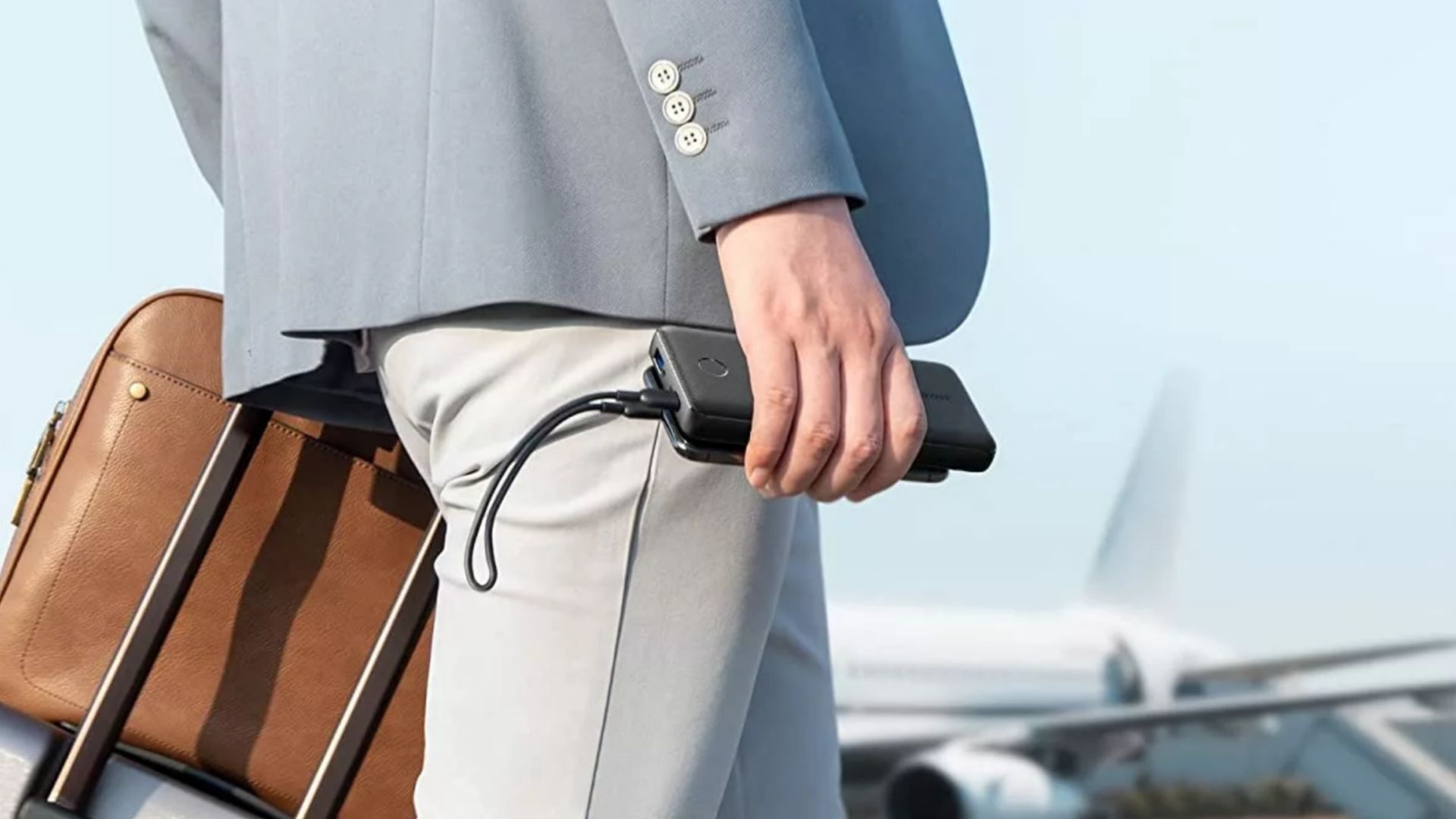

We may earn revenue from the products available on this page and participate in affiliate programs.
In an age where a dead battery could mean life or death — or, more likely, an inconvenience — a portable power bank becomes all the more necessary. A power bank has many names — portable battery charger, pocket charger, battery pack — but no matter what it’s called, it’s a device used to charge portable electronics. Finding the best portable power bank requires understanding a little bit about them.
Without getting into the weeds on the technology, power banks are measured in milliamp hours, or mAh. High-capacity power banks contain more mAh. For example, 5,000 mAh is enough juice to charge an iPhone once, while 10,000 mAh is enough to charge it twice. You use a powerbank the same way you’d use an electrical outlet: You connect a charging cable to the powerbank and then plug the cable into the device you want to charge.
In this article, we list the best portable power banks available today, along with what we looked at to find them and other things you should know about them before spending your hard-earned cash.
- Best Overall: Anker PowerCore Essential 20000 PD
- Best Solar: GoalZero Venture 75 + Nomad 10 Kit
- Best Budget: DJROLL Solar Power Bank 36000
- Best for Camping: Anker PowerCore Solar 10000
- Best High-Capacity: TechSmarter TSBar Rugged 30000
- Best for Laptops: Anker 747
- Best Compact: Dark Energy Poseidon Pro
- Honorable Mention: NOCO BoostX GBX45
Best Overall
Anker PowerCore Essential 20000 PD
Pros
- Great capacity
- Wide fast-charging compatibility
- Handy travel bag and cable
- Premium look and feel
Cons
- No waterproofing
- Only two input/output connections
Product Specs
- Capacity: 20,000 mAh
- Connectors: USB-C and USB-A
- Charging time (powerbank): 7 hours at 20W, up to 20 hours with regular USB-A
- Charging standard: 18W power delivery, Power IQ
- Water resistance: None
Why It Made The Cut
- The Anker PowerCore is a straightforward fast charger that’s lightweight, high-capacity, and easy to use. Add a super slick look and handy extras, the PowerCore really earns the title of best overall.
Best Solar
GoalZero Venture 75 + Nomad 10 Kit
Pros
- Dedicated solar panel
- Rugged outdoor-oriented design
- Great compatibility
Cons
- Flashlight only 50 lumens
- Nomad 10 is the smallest solar panel offered
Product Specs
- Capacity: 19,200 mAh
- Connectors: USB-C, 2x USB-A
- Charging time (powerbank): 1.5-2 hours with wall charger, 11-12 hours with Nomad 10 solar panel
- Charging standard: 60W USB-C, 15W USB-A
- Water resistance: IP67
Why It Made The Cut
- Portable, reliable and versatile, GoalZero makes it easy to customize your solar power needs with a variety of sizes for both solar panels and solar-ready power banks.
Best Budget
DJROLL Solar Power Bank 36000
Pros
- Great advertised capacity
- Lots of connectors, including wireless Qi charging
- Solar panel for emergencies
- Powerful multi-mode flashlight
Cons
- Power button prone to accidental presses
- Quite heavy
Product Specs
- Capacity: 36,000 mAh
- Connectors: USB-C, 2x USB-A, micro-USB, wireless Qi charging pad
- Charging time (powerbank): 9-12 hours with USB-C, ~120 hours with solar panel
- Charging standard: 3A max USB-C and USB-A, 2A max micro-USB, 1A max wireless Qi charger
- Water resistance: IP66
Why It Made The Cut
- Packed with features, the DJROLL Solar Power Bank 36000 offers amazing capacity and performance that rivals more expensive brands. Wireless Qi charging is a nice added touch, as well.
Best for Camping
Anker PowerCore Solar
Pros
- Very lightweight
- Great water/dust resistance
- Simultaneous charging plus trickle charge capability
- Good flashlight
Cons
- Small solar panel
- No USB-C
Product Specs
- Capacity: 10,000 mAh
- Connectors: 2x USB-A, micro-USB (input only)
- Charging time (powerbank): 5.5 hours via micro-USB
- Charging standard: 15W USB-A
- Water resistance: IP64
Why It Made The Cut
- Lightweight with great features, the PowerCore Solar is excellent for backpackers and lightweight hikers that still need some juice on-the-go, while great ruggedness rounds out the package.
Best High-Capacity
TechSmarter TSBar Rugged
Pros
- Very high-capacity
- Great connectivity with pass-through charging
- Excellent safety and protection features
- Great flashlight
Cons
- High-capacity means high weight
Product Specs
- Capacity: 30,000 mAh
- Connectors: USB-C, 3x USB-A
- Charging time (powerbank): 12 hours
- Charging standard: 1x 20W PD USB-C, 2x 20W TS+ USB-A, 1x 1A USB-A
- Water resistance: IP66
Why It Made The Cut
- Excellent capacity keeps your devices charged for days while the tough construction, excellent flashlight, and lots of fast-charging connectivity makes for a worry-free travel companion.
Best for Laptops
Anker 747
Pros
- Charge up to four devices at once
- Top-tier charging output for maximum laptop performance
- Advanced safety features with graphene layers
- High-quality LG lithium power cells
Cons
- Heavy
- No water resistance
Product Specs
- Capacity: 25,600 mAh
- Connectors: 2x USB-C, 2x USB-A
- Charging time (powerbank): 2.5 hours with 65W wall charger, 17 hours with 5W charger
- Charging standard: PowerIQ 3.0 87W max output
- Water resistance: None
Why It Made The Cut
- High-capacity and blazing fast 87W max output, the 747 also includes advanced safety and temperature features to keep your laptop safe while also charging up to four devices.
Best Compact
Dark Energy Poseidon Pro
Pros
- Extremely lightweight
- Virtually indestructible
- Great compatibility
Cons
- Average capacity
- Anemic flashlight
Product Specs
- Capacity: 10,200 mAh
- Connectors: USB-C, USB-A
- Charging time (powerbank): 4-5 hours
- Charging standard: 3A USB-C
- Water resistance: IP68
Why It Made The Cut
- Small but mighty, the Poseidon Pro is probably the toughest powerbank on the market, and one of the lightest too, while still delivering a good capacity and fast charging.
Honorable Mention
NOCO BoostX GBX45
Pros
- Jumps cars and charges electronics
- Huge capacity
- 100-lumen multi-mode flashlight
- Ultrasafe 2.0 protection
Cons
- Bulky
Product Specs
- Capacity: 31 Wh
- Connectors: 12V car starter, USB-C, USB-A
- Charging t(powerbank): 48 minutes
- Charging standard: 1250A car starter, 60W USB-C
- Water resistance: IP65
Why It Made The Cut
- Astounding versatility, durability, a powerful flashlight, and superb safety features for your car and devices means this jump starter pulls double-duty as a great, if bulky, powerbank.
Things to consider before buying a powerbank
Capacity
Naturally, higher capacity numbers attract more clicks, but keep in mind the kind of devices you’ll be powering. Most smartphones only have 2,000 to 5,000 mAh batteries, so just a 10,000 mAh power bank will get you two or more full charges. And the bigger the powerbank, the heavier and less portable it will be.
Safety features
Lithium batteries are great for charging high-tech devices, but they can be dangerous when not properly protected. Look for overvoltage protection, heat sensors, overcurrent protection, and similar electronic safety features to make sure fire and explosion hazards are kept at bay.
Charging standards
To get the fastest charge for your device, a little bit of research into what charging standard your smartphone, tablet, or other device uses will go a long way. It takes more than just a proper cable connection to get a good charging speed out of a fast-charge-capable device, check to make sure the powerbank you’re interested in is compatible with the type of fast-charge your device uses. It can be confusing with terms like Power Delivery 3.0 or 65W USB-C connectors, but most reputable power banks will list particular common devices to make it easier for shoppers to know if their device will receive the fast-charge it’s rated for.
FAQs about portable power banks
Q: How many mAhs is a good power bank?
A: Naturally, it depends on what you’re going to be powering, but most people are looking to keep their smartphone or tablet going, with the occasional other small device. Most phone batteries are between 2,000 and 5,000 mAh, so a powerbank between 10,000 and 20,000 mAh will get multiple full charges of these common devices. Higher capacities exist too, with a corresponding increase in weight.
Q: Which is better for a powerbank, 10,000 mAh or 20,000 mAh?
A: Most lightweight power banks will be around 10,000 mAh, so if you’re searching for a very portable power reserve, this is a good capacity to search for. If you don’t mind a little extra weight, 20,000 mAh power banks will give more charges to your devices. That said, also make sure the power bank has the same fast-charging standards as your device. High capacities make less of a difference to folks on the go if it takes hours and hours to charge their device.
Q: What should I look for when buying a powerbank?
A: In addition to the basics mentioned in the FAQ section, brand reputation goes a long way. High-quality brands will hold their stated capacities for longer, and have more safety features. If you’re going to be out in the elements a lot, water resistance and flashlights are great to have. Solar panels are good for emergencies, but unless you hook up a powerbank to a large dedicated solar array, they’re really only good to get enough charge for a quick emergency call.
Final thoughts
For an excellent daily driver in urban environments, the Anker PowerCore Essential is fast, portable, and high-capacity. The stylish package and handy travel bag make the PowerCore superbly portable and fit in any setting, from college to work or light camping. Anker’s record for safety and build quality make the PowerCore an easy choice for the Best Overall power bank. For those seeking a more off-grid lifestyle, the GoalZero Nomad solar panels are easy-to-use and rugged while their power banks are fast, durable, and reliable. On the budget side of the equation, the DJROLL 36000 offers high capacity and a diverse feature set at a great price.
Methodology
I tested dozens of power banks across a wide array of devices, including Samsung phones, Apple phones, my own GoPro camera, and several brands of laptops. I checked their capacities using a ChargeDoctor monitor to make sure they were as advertised throughout the span of this project. Most of my testing was in urban and workplace settings, but I had several opportunities to test out power banks in the great outdoors in places like Zion National Park, Catalina Island, and several state parks.
In addition to capacity and charging speed, I also looked for overall ruggedness and temperature tolerance. Portability was also a big factor in my testing, especially on longer trips. Thankfully, safety wasn’t an issue as all power banks I tested had great safety ratings, so no unexpected fires were encountered.
